Related Content
Content
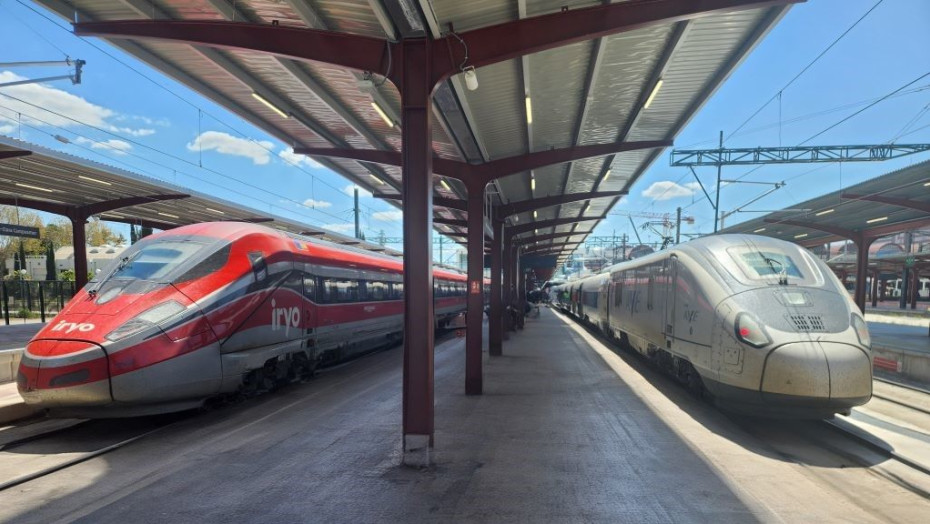
Travelling on Spanish trains
Spanish trains can be fabulous, but also bewildering, hence this guide to all that's good to know
Share
The trains in Spain are far from plain as most of them undoubtedly have the wow factor!
One thing which can be most obviously exhilarating about travelling on Spanish trains is their speed.
Spain has more high speed lines than other European nation and when using them the trains regularly travel at more than 300 km/h, which is also faster than the norm.
Though what can be a tad bewildering are the multiple categories of train service used by the Spanish national rail operator Renfe; plus there are now also competing services when travelling between many locations on the Spanish high-speed lines.
Hence there are often decisions to be made.
On some high speed routes there are up to four types of train service; plus there can be a choice of taking a high speed service, or a train service which is slower, because it solely uses the still remaining ‘classic’ lines.
The different train services matter not only in terms of journey time, they also impact on the tickets to travel by them - and affect multiple other aspects of rail travel such as:
- the experience of travelling 1st class,
- whether 1st class is even available.
- if non-folded bicycles can be taken on board.
- travelling with a dog, etc.
The influence of the railway network

The fact that the Spanish rail network is a combination of high speed and ‘classic’ lines partially explains the variety of the train services.
The names given to each type of service are indicators of:
- Whether they solely travel on the high speed lines.
- Use the high speed lines for part of the journey and then travel beyond them to reach destinations only served by the ‘classic’ network.
- Solely travel on the older ‘classic’ lines.
Though in recent years exceptions to these naming conventions have begun to occur.
The reasons for this include that the expansion of the Spanish high-speed rail network has gone ahead of the delivery of new trains.
Also despite the high speed evolutionm so that the Spanish themselves can better understand the train services in their areas of the country, what have been long-standing conventions over the names of some trains have been retained
Along the north coast
Along the mountainous Atlantic coastline in northern Spain building the ‘classic’ lines would have been too expensive.
So a network of narrow-gauge railways, similar to those which can be found in parts of Switzerland, had to be constructed instead.
Rattling through a coastal ravine on these trains is at opposite end of the special rail travel experiences spectrum, to rushing across the sun-baked central plains at more than 300 km/h.
Technical Explanation Alert:
There is a piece of railway knowledge that can make the differences between the types of train service in Spain easier to understand.
It’s to do with the space between the rails on the track, which is known as the ‘gauge’.
On the older ‘classic’ lines in Spain, this is wider than on the railway tracks in other western European countries that use a standard gauge.
However, the Spanish high-speed lines have been constructed to this standard gauge, so when some of the larga-distancia train services travel on to destinations not served by the high-speed lines, they have to switch between the gauges.
So the names of some Spanish train services are indicative of the fact that they make this switch, as these are the trains which use the high speed line for only part of the journey.
Passengers remain on the train, it just has to slow down for a couple of minutes, so that a machine can adjust the wheels.
The variety of trains
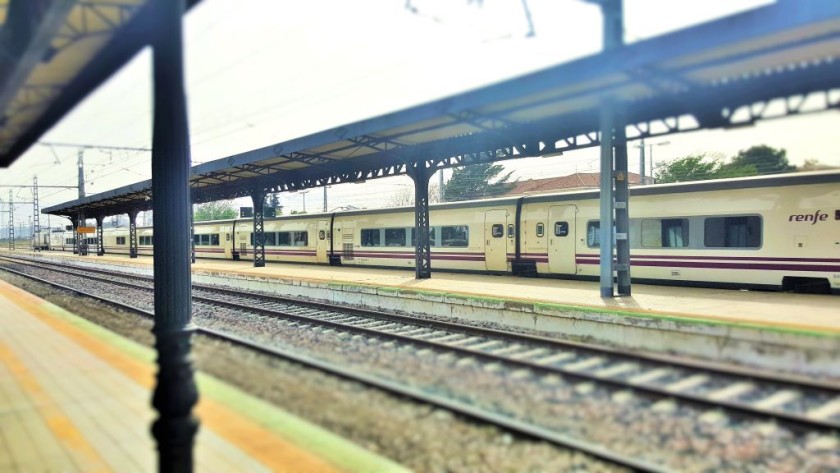
Something which can be special about Spanish rail travel are the trains which are uniquely Spanish.
The dominant manufacturer Talgo has taken a unique approach to the design of trains, which comprise comparatively short low-slung coaches, in which most of the seats can be rotated by the train staff, so that they face forward.
Talgo has somewhat inevitably constructed most of the trains which uniquely switch gauges between the high-speed lines and ‘classic’ lines.
Though many of the express trains currently used on the high speed lines in Spain aren’t Spanish at all; and are in fact variations of high speed trains which can be found in France, Germany and Italy.
Also some of the trains used on a few ‘classic’ routes are actually Danish - one of many of the different types of train that don’t use the high speed lines.
The types of train service explained
The starting point of understanding which type of train service you will be travelling by, is that when travelling between different cities and towns, the national rail operator, Renfe, groups its train services by distance travelled.
With the self-explanatory names of:
- Larga-Distancia
- Media-Distancia.
The Larga-Distancia Services
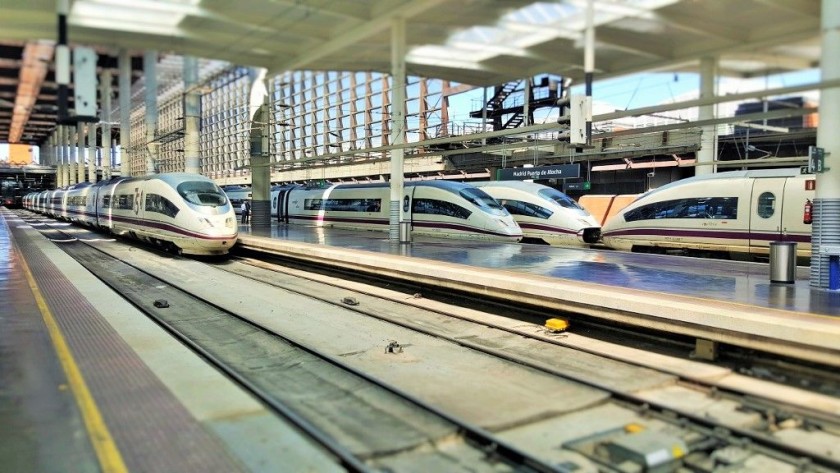
There's no hiding that there are multiple types of express train services in Spain.
1: Those which solely travel on the high speed lines:
These include:
- The AVE services which are operated by Renfe; with the trains themselves differing per route:
Those which are versions of the German ICE 3 trains are used for Madrid ↔ Barcelona services, the versions of the French TGV trains are used for Madrid ↔ Sevilla services,
Spanish designed trains also used on all high speed routes. - The iryo services deploy imported clones of the trains used for the smart Frecciarossa 1000 services in Italy, which compete with AVE trains on the routes between Madrid and Alicante, Barcelona, Malaga, Seville and Valencia.
- The avlo services use the same Spanish trains that are deployed by Renfe on AVE services, but avlo services have entirely different interiors.
Because Renfe uses them as a lower cost, but more basic alternative to the AVE services on the routes between Madrid and Alicante, Barcelona, Girona, Malaga, Murcia, Seville and Valencia. - The Ouigo services in Spain emulate those in France, by combining a more basic travel experience with lower fares.
They can be found on the routes between Madrid and Alicante, Barcelona and Valencia.
An exception is that the trains which solely use the high-speed lines between Madrid and both A Coruna and Cadiz, are still branded as Alvia services – see below
2: Those which travel on both high-speed and ‘classic’ lines:
These include:
- The Alvia services which primarily connect Madrid with cities in northern Spain - though Alicante and Valencia are also linked to northern Spanish destinations by these services .
A variety of trains are used for these services, with variations of these trains used on routes between Madrid and A Coruna, Cadiz, Ferrol, Gijon, Santiago de Compostela and Vigo – and these trains, used on routes to Bilbao and San Sebastian from both Barcelona and Madrid. - The Euromed servcies on the Barcelona ↔ Valencia – Alicante route - the same trains which are used on the routes between Madrid and north-west Spain are used for these services.
- The Torre Oro service – the same trains which are used for the Euromed services are used on its Barcelona – Valencia – Albacete – Cordoba – Seville – Cadiz route
- The InterCity services - which primarily travel beyond the high speed lines to destinations which aren’t served by electrified railways such as Algeciras and Ronda.
Though the exception to this rule is that some Intercity services only use the ‘classic’ lines, in particular the trains on the Barcelona ↔ Valencia route which still travel via the city centre station in Tarragona.
The Media-Distancia Services
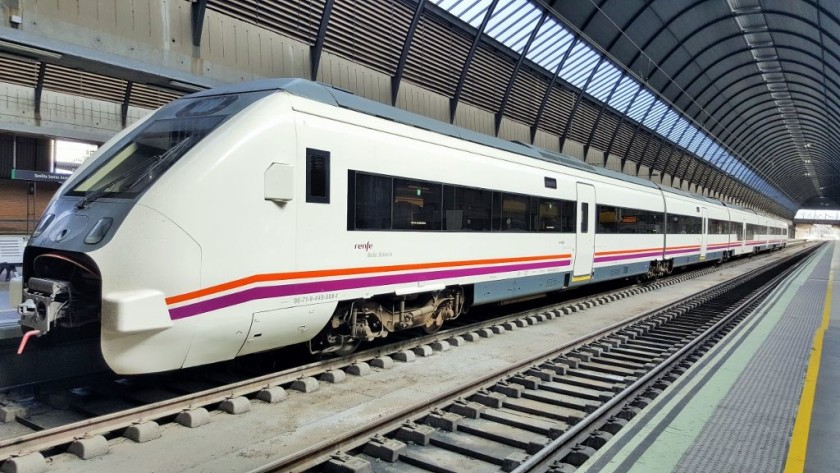
These are the equivalent of regional train services in other European countries and they are placed in three different categories.
(1) Avant (Av) = these 2nd class trains only trains solely travel on high speed lines, but on shorter distance routes, such as Madrid ↔ Toledo and Malaga ↔ Seville.
In common with the long-distance high speed services, seat reservations are assigned on these services when booking tickets
Though this Avant category doesn’t seem to have been applied to more recent shorter-distance high-speed services such as Malaga ↔ Granada or Vigo ↔ Santiago de Compostela.
(2) Media Distancia (MD) = These are the services which are specifically branded as MD on the Spanish timetable.
They are found all over Spain on the non high-speed, 'classic network', so more than eight types of train are used, though many of them are 2nd class only.
Seat reservations are assigned on these trains when booking tickets - except on the Barcelona <> Port Bou via Girona route.
Non-folding bicycles can be taken on board the trains used for MD services.
In effect there are five types of MD services:
- Trains which travel fairly lengthy routes between cities that are not taken by direct express (larga-distancia) trains.
These routes include Madrid ↔ Almeira, Madrid ↔ Jaen and Valencia ↔ Zaragoza. - Trains which still travel on the routes which have been abandoned by express trains, because those express trains have been switched to the high- speed lines.
When that is the case, these MD services can provide a slower, but cheaper, alternative to taking a high speed train.
Also some of these MD services can travel long-distances including Madrid ↔ Barcelona via Reus and Madrid ↔ Seville via Caceres. - Trains which share the non-high speed sections of the routes taken by Alvia and IC services. On these routes these MD train services tend to be cheaper, than those alternative 'larga-distancia' services.
- Some shorter-distance high-speed routes, which haven’t been branded as Avant services.
- Routes which are also taken by Regional Express trains; and on these routes the MD trains provide a faster service, because they skip more stations.
(3) Regional Express services which are 2nd class only and on which seat reservations aren’t available
So for rail pass users these are the only trains on which seat reservations are not mandatory.
Though they can only be found on relatively few shorter distance routes including Barcelona ↔ Figueres and Reus, Leon ↔ Gijon and Vallodolid ↔ Santander.
How it impacts on ticketing
The type of train service can matter when booking tickets for Spanish rail journeys, but when there isn't a choice of travelling by different train services, it obviously isn't so relevant.
But on many rail routes within Spain, there is a choice, hence these notes:
Four things that are good to know
1: There are types of ticket which are specific to the iryo and Ouigo services, but on the trains operated by the national company, Renfe, there aren't tickets which are specific to each train service.
Instead the full range of ticket types sold by Renfe may not be available.
For example, Prémium tickets are only available when travelling on AVE and Euromed services.
Also only Basico tickets can be booked when travelling on the avlo services - and when 1st class seating isn't available, as on the Avant and many MD branded services, it won't be possible to upgrade the Elige type of ticket.
2: When travelling on the high-speed routes between Madrid and cities in eastern and southern Spain, there will be a choice of three or more train services and the core idea is that the more basic avlo and Ouigo services, when available, will be cheaper.
Though tickets to travel by the iryo services also tend to be competitively priced.
So it can be worth using Trainline or Trenes to compare the costs and timings of the multiple services on these routes.
3: When travelling between some destinations there can be a choice of taking a high-speed train service, or one which uses the 'classic' line, so is slower.
The slower alternatives will be cheaper.
4: On all of the larga-distancia services, the Avant services and nearly* all of the MD services, seat reservations are mandatory, so will be included when booking tickets.
Therefore rail pass users must arrange reservations prior to boarding - note that rail pass reservations aren't available at all on the avlo, iryo and Ouigo services.
*= the main exception are the trains on the Barcelona - Girona - Figueres - Port Bou - (Cerbere) route.
travelling with children
When travelling on most train services operated by Renfe, children aged 5 -13 and under are entitled to a 40% discount on any of its rail tickets.
The exception to this 'rule' are the avlo services, because on these services children aged 13 and under travel at a flat rate of only €5, regardless of distance.
So on the routes between Madrid and Alicante, Barcelona and Valencia when there is a choice of travelling on an AVE or avlo service; or by the iryo and Ouigo services, what's good to know is that these services have different child ticket policies.
In effect child discounts don't seem to be available at all on iryo services - the info on its website states that children between 4 and 13 years of age will 'travel at a reduced fare according to the children's fare available in the sales channel' - but SMTJ looked up more than twenty journeys and didn't see these child rates.
In contrast, on the Ouigo services children between 4 and 13 years of age travel at a flat rate of only €7.
On the routes between Madrid and Malaga, Murcia and Seville there can be a choice of travelling on AVE, avlo, or iryo services.
travelling with bicycles
The type of train service you will be travelling by particularly matters if you'll want to travel in Spain with a bicycle.
Non-folding bikes can only be taken on board any of the larga-distancia and other high-speed services, if they are disassembled and placed in a bag or case measuring no more than 120 x 90 x 40cm (length-height-width).
The train services on which this policy applies are these:
If you don’t want to disassemble a non-folding bike and will be travelling between cities and towns, you can only take it on these two train services:
1: Those specifically branded MD
2. The Regional-Express services.
If you will be travelling for less than 100km, you apparently don’t need a ticket, but for longer journeys there is flat rate bike transport fee of €3, which can be booked at station, or online on the Renfe website.
Adding the bike to an online booking will typically also ensure your bike will have a reserved place on the train.
travelling with dogs
When travelling on most of the larga-distancia services - the Alvia, avlo, Euromed, Intercity, iryo and Ouigo services, you can only take a dog if it travels in a container measuring no more than 60x35x35 cm and does not weigh more than 10kg - special tickets are still required, or the pet carrier has to be paid for as an additional piece of luggage.
This policy also applies when travelling on most AVE services, but on the routes between Madrid and Alicante, Barcelona, Valencia and Zaragoza, if your dog weighs between 11kg and 40kg it can be taken on a few specific departures.
These departures now have a dog paw symbol, when looking up a journey on the Renfe website.
Though you will need to select the more expensive 'Elige' tickets and the reservation fee for the dog is €35.
On the other trains operated by Renfe, including the Avant, MD and Regional-Express services, the dog can weigh more than 10kg and it doesn't have to be placed in a container.
For travel on these services it looks as though the dog ticket price will be 25% of the Adult rate.
Boarding
The trains which travel on high speed lines: the AVE, Alvia and Avant services are also classified as 'Alta Velocidad' services.
When these train services all depart from a particular part of a station, you may encounter a sign pointing the way to the 'Alta Velocidad' trains.
If you are taking a train which has compulsory reservation, the Coche (coach/carriage) and Plaza (seat numbers) are on your ticket.
On the larga and media-distancia services, many the coaches/carriages will only have one door on each side of the train, so you don’t have to choose between doors when boarding.
Then when you’re on the train, look for the seat number, there is nothing else to indicate which seats are reserved and which are free.
For any journey by a larga-distancia train service, the AVE, Alvia, IC and Torre Oro trains you must travel in the seats you have been assigned.
On board summary
1st class = ‘Comfort’ and ‘2nd class = ‘Estander’.
(Until recently Preferente indicated 1st class and Turista indicated 2nd class)
If you’re lucky enough to be travelling in 1st/Comfort class, when you first encounter the train conductor/manager, they may say “Presse”.
If they do, they’re asking if you would like a complimentary newspaper and not asking if they can check your ticket.
The on board announcements will be bilingual, but the station names of the calling points will be in Spanish.
So it’s worth being aware of the full name of the station you will be heading to.
Be aware that the station names in Spain are rarely based on their location; stations tend to be named after people or nearby sites of religious significance.
Catering
On-board catering isn't available on the media-distancia services, but on most of the larga-distancia services an on-board bar/bistro car will be available - and a catering trolley may also be taken through the train.
The exceptions are:
- An at seat menu of hot meals will be served to Premium ticket holders on AVE and Euromed services; Saturdays excepted.
- When travelling in Ifinita class on the iryo services, there is also a complimentary at seat, hot meal service.
- When travelling on the Alvia, AVE and Euromed services, when booking the 'Elige' type of ticket you can opt to add a Boxed Meal as a paid for additional service.
- The avlo services do not have bar/bistro cars, instead they have vending machines from which drinks and snacks can be purchased.
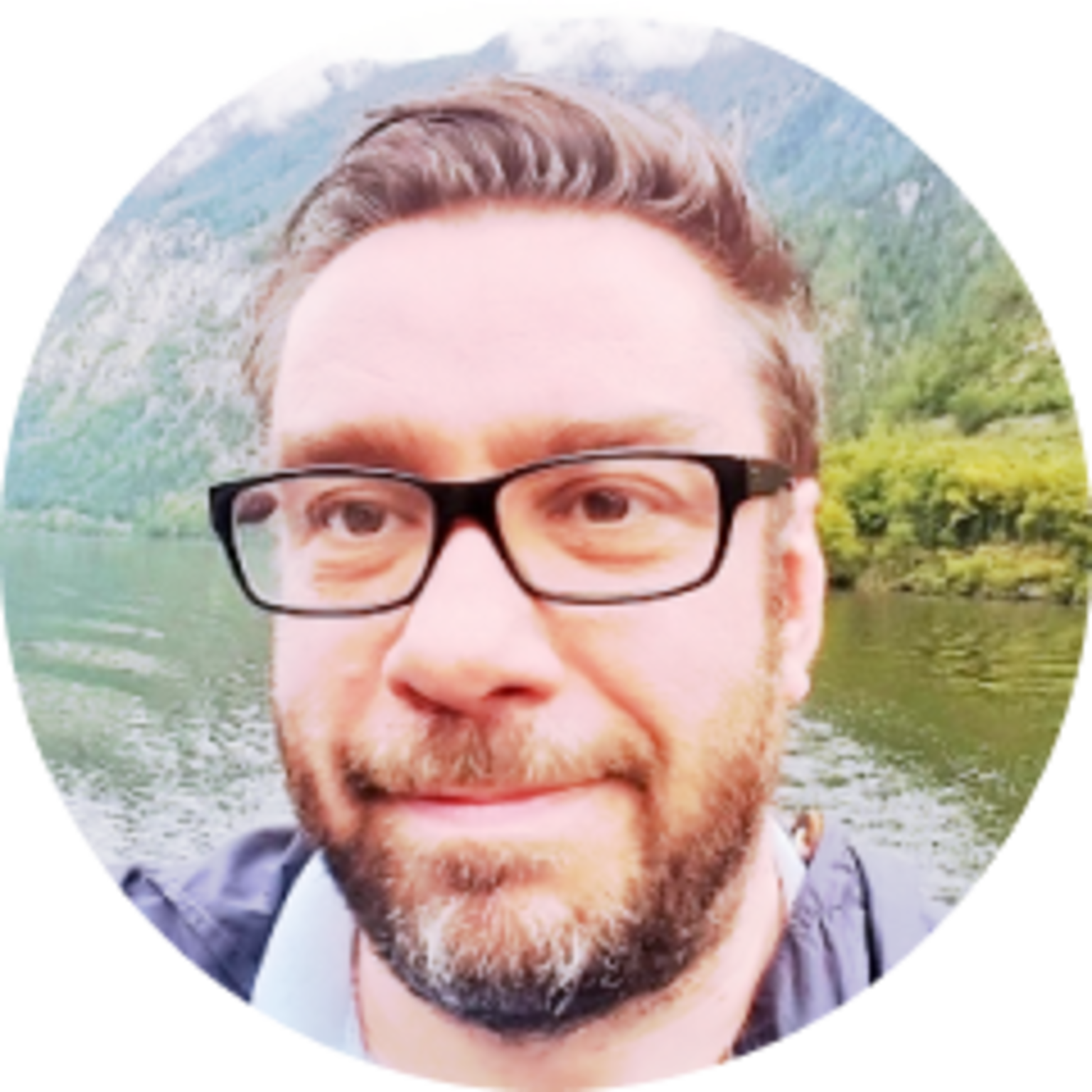
Simon Harper
I wanted to share my passion for train travel and explain how anyone can take the fantastic journeys I have taken.

This is one of more than 100 train travel guides available on ShowMeTheJourney, which will make it easier to take the train journeys you want or need to make. As always, all images were captured on trips taken by ShowMeTheJourney.
This second version of ShowMeTheJourney is exciting and new, so we are genuinely thrilled that you are here and reading this, but we also need your help.
We’re striving not to let anything get in the way of providing the most useful service possible, hence a facility has been set up with DonorBox which can be used to support the running costs and make improvements.
Instead of advertising or paywalls, your financial support will make a positive difference to delivering an enhanced service, as there’s a lot of ideas which we want to make happen.
So if you have found the info provided here to be useful, please consider saying thank you.




